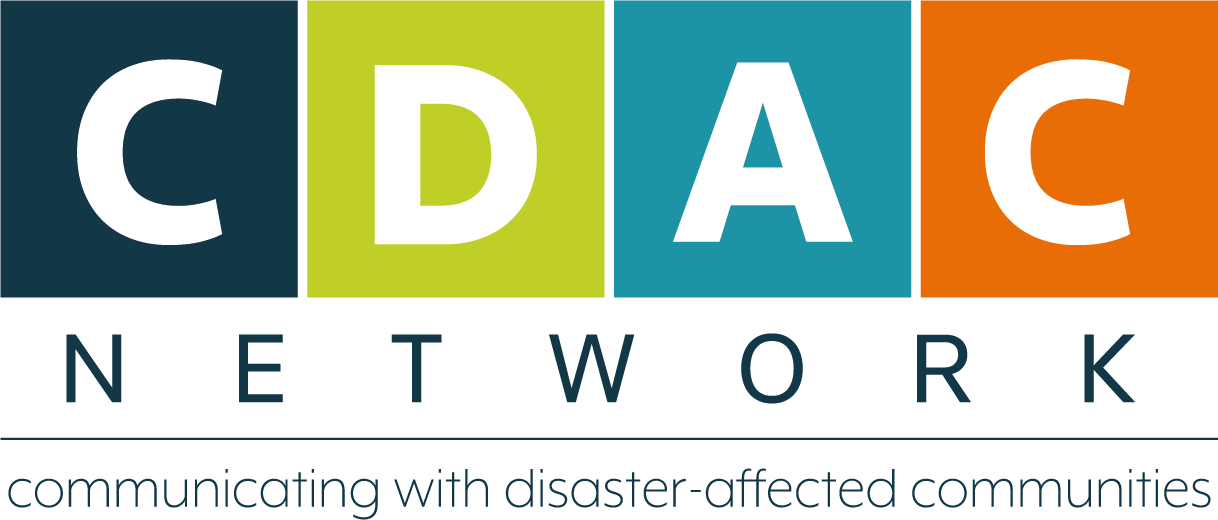Resources
Search our resources
Or filter resources by
Country/region
- Afghanistan 2
- Africa 32
- Americas 3
- Asia 11
- Bangladesh 3
- Belarus 1
- Burkina Faso 3
- Caribbean 7
- Chad 1
- Colombia 3
- Cote D'Ivoire 1
- DRC 1
- Dominica 2
- Ethiopia 3
- Europe 10
- Fiji 6
- Global 57
- Guinea 1
- Haiti 4
- Hati 1
- Horn of Africa 8
- Indonesia 1
- Iraq 1
- Kenya 10
- Libya 1
- Malawi 1
- Middle East 9
- Morocco 2
- Mozambique 4
- Myanmar 2
- Nepal 3
- Niger 2
- Pacific 19
- Pakistan 4
- Palestine 3
- Papua New Guinea 10
- Philippines 6
- Sierra Leone 1
- Somalia 3
- South Sudan 2
- Southeast Asia 7
- Sudan 6
- Syria 3
- Turkiye 3
- Ukraine 6
- Vanuatu 5
- Yemen 1
- Zimbabwe 1
Topic
- #safeai 3
- #safeaihumanitarianengagement 1
- #safeaiparticipation 3
- AI 7
- CDAC Public Forum 13
- COVID-19 12
- DEPP 7
- Digital security 2
- Ebola 1
- Lebanon 1
- Local Lifelines 3
- Myanmar 1
- National Platforms 9
- PSEA 2
- SMS 2
- Sudan 4
- accountability 47
- capacity bridging 15
- cholera 2
- climate 11
- co-design 3
- communication 110
- community engagement 80
- conflict 19
- coordination 51
- cyclone 3
- development 1
- digital 30
- digital hygine 1
- disability 2
- disaster 41
- displacement 14
- drought 3
- earthquake 13
- feedback 7
- financing 5
- floods 3
- harmful information 1
- health 16
- hotline 1
- hurricane 2
- inclusion 11
- information 70
- information integrity 7
- journalism 31
- localisation 28
- media 50
- media development 3
- misinformation 7
- needs assessment 7
Global frameworks and commitments on communication and community engagement
There are a number of global level frameworks and commitments that have components specific to communication and community engagement. While these spell out what action needs to be taken, they are not consistently and coherently taken on board by humanitarian actors. This paper summarises those existing frameworks.
Prepositioning national platforms: an independent evaluation of CDAC's work under the Disasters and Emergencies Preparedness Programme (DEPP)
This evaluation found that the flexible funding that the national multi-stakeholder platforms had access to helped the platforms develop their own capacity strengthening plans based on gaps analyses they undertook, resulting for example in locally adapted tools and skills in communicating with communities.
An assessment of surge capacity available for communication and community engagement
An assessment of the level and quality of surge capacity available for communication and community engagement in the humanitarian sector.
The characteristics of different communication channels
A description of different communication channels, their coverage and reach, the type of information that is suitable for dissemination in this way, the level of interactivity with the audience, and the cost. This document is useful in the planning of communication and community engagement activities.
Dominica: Media & Telecommunications Landscape Guide
This guide provides comprehensive information on the media and telecommunications landscape in Dominica, as at October 2017.
Better dialogue, better information, better action
Lessons on communicating with communities in emergencies.
12 essentials for system change
The ‘12 essentials for system change’ came out of a global forum held in May 2017 by CDAC Network and the Steering Committee for Humanitarian Response, on ‘The authenticity challenge to the Participation Revolution’.
The authenticity challenge to the participation revolution
Background discussion papers for the 2017 CDAC Public Forum: (1) Participation and community engagement: the challenge to make it authentic; and (2) Seeing the woods and the trees: the quiet rise of community philanthropy.
Rumour has it: a practice guide to working with rumours
This guide offers approaches, practices and tools to working with rumours and misinformation. It is aimed primarily at humanitarian programme managers and field staff to provide them with practical tips on how to work with rumours in their response programmes in a way that is achievable amid competing demands.
Policy brief: The role of collective platforms to support communication and community engagement in humanitarian action
This independent review commissioned by CDAC Network confirms that the establishment of collective approaches to communication and community engagement – at national and global levels – is required to be more systematic and effective and has significant support across the humanitarian sector.
The role of collective platforms, services and tools to support communication and community engagement in humanitarian action
This independent review confirms that the establishment of collective approaches to communication and community engagement – at national and global levels – is required to be more systematic and effective and has significant support across the humanitarian sector.
Stepping up to the challenge of community engagement in a digital age: creating dialogue and ‘virtual safety nets’
Outcomes report from CDAC Network’s joint event with the ICRC and DFID in September 2016. The event brought considerable energy to a complex number of issues around communicating with people living in dire circumstances that must be resolved.
South Sudan communication with communities – gaps and needs analysis
Comprehensive communication and community engagement needs analysis in South Sudan.
Are you listening now? Community perspectives on communication with communities during the Nepal earthquake
An assessment of whether, in the aftermath of the Nepal earthquakes in April and May 2015, people were getting information that was useful and relevant to their needs.
Study on communication with communities (CwC) gap analysis in Bangladesh
Based on the experience of CwCiE working group, a formal multi-stakeholder platform called Shongjog was formed in 2015. To set the strategic priorities of Shongjog, a gap analysis study was launched later in 2015.
Creating an internally displaced persons information centre in Iraq
A case study about the interagency information centre for internally displaced persons that opened in Iraq in July 2015.
Monitoring citizen voices during the Ebola Crisis, Sierra Leone
This case study follows Ground Truth Solutions’ activities through the Ebola Crisis of 2015 where it administered regular surveys to provide decision-makers with regular, real-time feedback from citizens about the aid they were receiving.
In Nepali: information and communication questions for needs assessments
As part of their support to the Nepal earthquake response, Translators without Borders translated 10 key questions on information and communication needs into Nepali.
Results-based protection and communicating with communities: summary and analysis
This paper summarises a webinar and online discussion held by the Interaction Results-Based Protection Programme and the CDAC Network on ‘Communicating with communities: analysing the role of information and the flow of communication with affected populations to address protection outcomes’.
Fanning the flame: the CDAC Network – a movement for change
This paper charts the story of the CDAC Network from the now infamous ‘pub meeting’ in New York in 2009 to the Network’s first Members’ Council in May 2014. It tells the story of the Network’s formative years: a time of forming and storming as the diverse membership set about building a movement for fundamental change in the way the humanitarian sector operates.




















